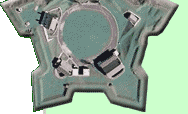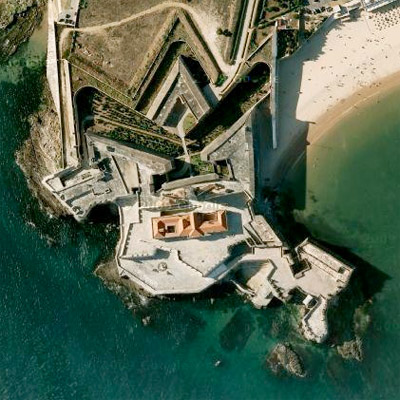
 |
 |
Forte de Sao Juliao da Barra Lisbon, Portugal |
 |
 |
 |
 |
 |
||
 |
History has shown that any place that has what will work as a really great port for ships is going to be fought over. Consider Lisbon, Portugal. If you've ever seen that
city on a map, you've probably been overwhelmed with the unquenchable desire to attack whomever is currently in charge of it and violently wrest it from their grasp: That is how
awesome a port is Lisbon. Iberians, Celts, Phonecians, Cathaginians, Romans, Lusitanians, Sarmatian Alans (a nomadic tribe that came all the way from the caucusus region), Visigoths and Moors all cherished, fought over, possessed and eventually lost Lisbon. By the 12th century, the Reconquista had swept through the Iberian peninsula, returning Spain and Portugal to Christianity: Lisbon was Reconquisted by Alfonso I (1109-1185) in 1147. Lison became Portugal's capital in 1255. By the 16th century Lisbon was a galloping hub of commerce with Africa, India and the far east. A primitive structure was thrown together in the current fort's location in 1549, but everyone who saw it laughed at it, so a real fort was needed. Construction of Forte de Sao Juliao da Barra was begun in 1553, in the interest of controlling the entrance of the Tagus River, which leads to the aforementionedly awesome port at Lisbon. Work continued until 1573, mostly accomplished with forced labor: Unlucky folks who were imprisoned in the dungeons of the very fortification on which they worked. Along with the Forte de Sao Lourenco Bugio across he river, Sao Juliao was part of the United Shield, controlling shipping and securing Lisbon from seaborne attack. Portugal's King Sebastian (1554-1578) managed to get himself killed on August 4 1578 in the Battle of Ksar El Kebir, part of an ongoing crusade against the wicked Moroccans. Sebastian was heirless, and his death set off a succession crisis that led to disaster for Portugal. As impressive and unlaughworthy as Forte de Sao Juliao da Barra was, it didn't do much to prevent Spain's King Phillip II (1556-1598) from capturing Lisbon and the rest of Portugal in 1580: The fort was besieged on its landward side by Spanish troops, and capitulated after six days. Portugal remained part of Spain until 1640, when revolts in Lisbon, which included another landward besiegement of the now Spanish-held forte, freed Lisbon, and the rest of Portugal by 1668. Forte de Sao Juliao da Barra again did nothing to prevent the forces of Napoleon (1769-1821) from marching into Lisbon on September 30 1807. The fort was made into the French occupying power's headquarters, and the Tagus River was blockaded by the British Navy. The French did their war-losing thing, and on August 30 1808 the Sitra Convention was signed, by which the 20,900 defeated French troops, carrying all of their "personal property," which primarily consisted of looted Portuguese valuables, were ferried out of Portugal by the British Navy and landed at Rochefort. The British took control of Forte de Sao Juliao da Barra, and used it as a prison for Portuguese people who were a little too vocal about wishing the British weren't there. The most famous victim of British heavyhandedness of the era was Gomes Freire de Andrade, a Portuguese citizen who had been a General under Napoleon until 1814. De Andrade was at the forefront of a movement to restore Portuguese independence from Britain, which had made Portugal little more than a protectorate after rescuing the country from Napoleon. De Andrade was executed on October 18 1817. Today seen as a hero, a headstone and image of de Andrade fashioned out of tiles is on the doorway to the forte's lighthouse tower. The Portuguese Civil War (1828-1834) was fought over another royal procession crisis, and naturally the French had to become involved. In 1831 a French fleet sailed past the forte, which fired cannon ineffectually in their direction. Way to go, forte. Still used as a lighthouse and prison but militarily obsolete by the middle of the 20th century, the forte was transformed into a sumptuously appointed reception hall, and hosted galas for soon-to-be US President Dwight D. Eisenhower (1890-1969) in 1951 and Field Marshal General Bernard Law "Monty" Montgomery (1887-1976) in 1952. Today, the Forte de Sao Juliao da Barra is the home of Portugal's Defense Minister and is available to visit by appointment, as long as you don't mind stepping carefully over the Defense Minister's dirty underwear. A note: Forte de Sao Juliao da Barra is not to be confused with Forte de Sao Joao da Barra, a lovely starfort in nearby Cabanas, Portugal. For goodness' sake, Portugal. Seriously. |
 |
 |
||
|
|
|||||||
Info Source 1
Info Source 2
Info Source 3
Info Source 4 Info Source 5 Info Source 6 Info Source 7 Info Source 8 Info Source 9 Info Source 10 Info Source 11 Info Source 12 Info Source 13 Info Source 14 Thanks to Google Maps for the image! ©2010 starforts.com |
 |